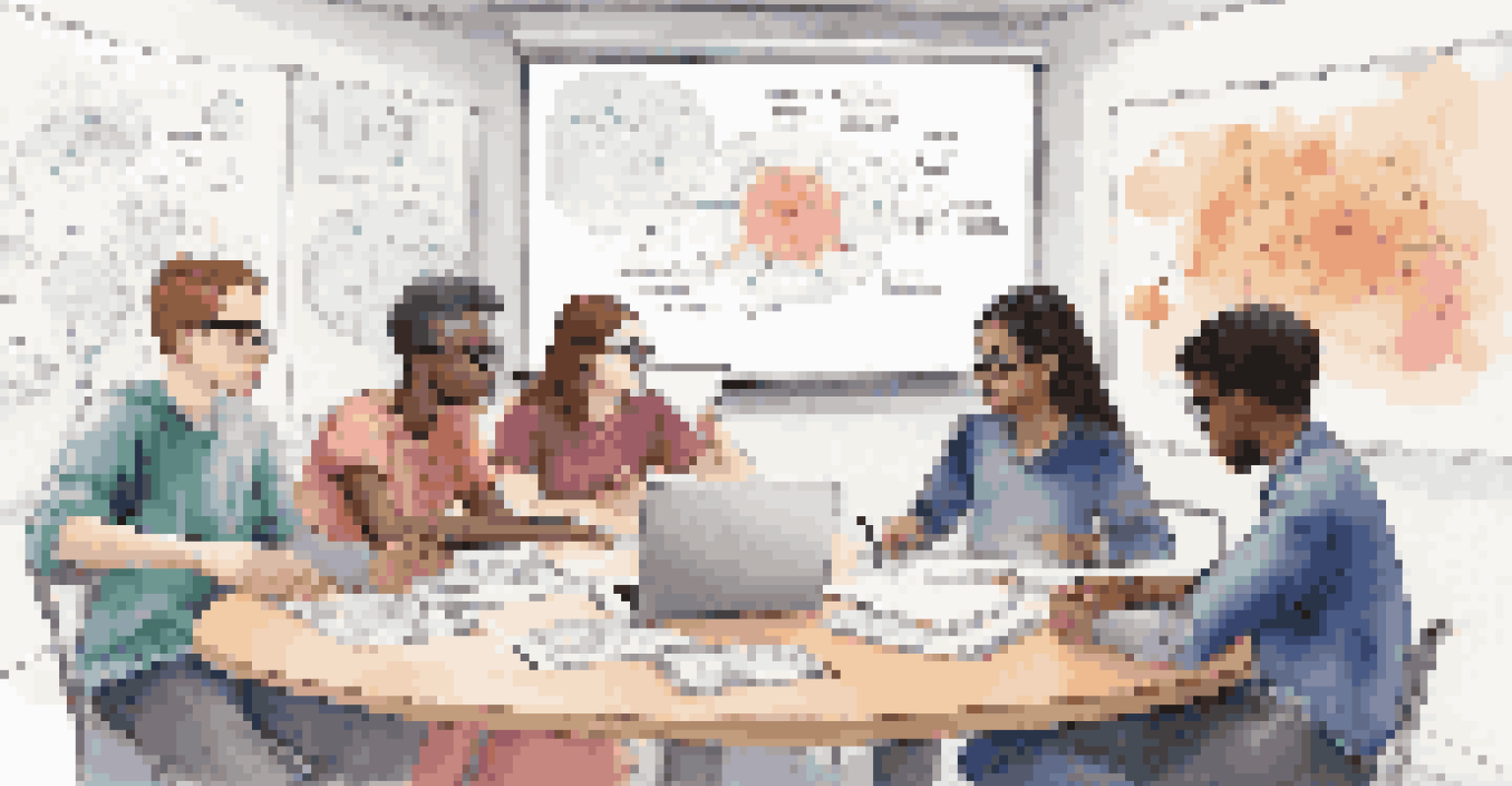The Importance of Interdisciplinary Learning for Cognitive Skills

Understanding Interdisciplinary Learning
Interdisciplinary learning is an educational approach that integrates multiple subjects or disciplines. By blending knowledge from different fields, students can form a more holistic understanding of complex concepts. This method encourages curiosity and critical thinking, as learners make connections between seemingly unrelated ideas.
Education is not the filling of a pail, but the lighting of a fire.
For instance, consider how a student studying environmental science may also delve into economics and social studies. This overlap helps them see the bigger picture of climate change, incorporating scientific data with societal impacts and economic policies. Such connections not only deepen knowledge but also foster a greater appreciation for the complexity of real-world issues.
Ultimately, interdisciplinary learning equips students with the tools to tackle multifaceted problems, promoting a well-rounded education that prepares them for diverse challenges in life.
Enhancing Critical Thinking Abilities
One of the most significant benefits of interdisciplinary learning is the enhancement of critical thinking skills. When students are exposed to various perspectives, they learn to analyze information more thoroughly and make informed decisions. This skill is essential for navigating the complexities of modern life, where problems often require multifaceted solutions.

For example, a project that combines history, science, and art can encourage students to evaluate evidence from multiple viewpoints, leading to richer discussions and deeper understanding. By synthesizing information from different disciplines, learners can develop a more nuanced approach to problem-solving.
Enhancing Critical Thinking Skills
Interdisciplinary learning improves students' critical thinking by exposing them to multiple perspectives, allowing for a deeper analysis of complex issues.
As they grapple with different ideas and frameworks, students become adept at questioning assumptions and recognizing biases, which are crucial components of effective critical thinking.
Fostering Creativity Through Diverse Perspectives
Interdisciplinary learning is a hotbed for creativity, as it encourages the mixing of ideas from different fields. When students engage with varied disciplines, they are more likely to think outside the box and come up with innovative solutions. This kind of creative thinking is vital in a world that increasingly values originality and adaptability.
The future belongs to those who learn more skills and combine them in creative ways.
Consider the artistic endeavors of a student studying both fine arts and physics. They might create a sculpture that explores the concept of balance through the lens of gravitational forces. This unique blend not only showcases creativity but also illustrates how interdisciplinary knowledge can lead to groundbreaking artistic expressions.
By embracing diverse perspectives, students not only enhance their creative capabilities but also learn to appreciate the beauty that arises from the intersection of different fields.
Improving Collaboration Skills Among Students
Interdisciplinary learning naturally fosters collaboration, as students often work in teams to tackle complex projects. This teamwork encourages them to communicate effectively, share ideas, and respect differing opinions. These collaboration skills are invaluable in the workplace, where teamwork is often essential for success.
For instance, a group project that involves science, technology, engineering, and mathematics (STEM) can help students learn how to merge their strengths. Each member may bring unique expertise to the table, requiring them to negotiate roles and responsibilities while valuing each other's contributions.
Fostering Creativity and Innovation
By blending ideas from various fields, interdisciplinary learning encourages creative thinking and leads to unique solutions and artistic expressions.
Through these collaborative experiences, students not only build lasting relationships but also learn to navigate group dynamics, which is a critical skill in any career.
Cultivating Self-Directed Learning and Curiosity
Interdisciplinary learning encourages students to take charge of their education, fostering self-directed learning and curiosity. When subjects are interconnected, learners become more engaged and eager to explore topics that pique their interest. This intrinsic motivation is essential for lifelong learning.
For example, a student fascinated by both literature and psychology may take the initiative to research how character development mirrors psychological theories. This self-directed exploration not only deepens their knowledge but also cultivates a love for learning that extends beyond the classroom.
By promoting curiosity and independence, interdisciplinary learning prepares students to seek out knowledge throughout their lives, making them adaptable and well-rounded individuals.
Building Resilience Through Challenging Concepts
Interdisciplinary learning often presents students with challenging concepts that require resilience to overcome. By navigating these complexities, learners develop persistence and problem-solving skills, which are crucial in both academic and personal settings. This resilience helps them tackle future challenges with confidence.
For instance, a student working on a project that combines biology and ethics may face difficult questions about genetic engineering and its societal implications. Engaging with these tough topics fosters resilience as they learn to confront ambiguity and uncertainty in their conclusions.
Preparing for a Dynamic Workforce
Embracing interdisciplinary learning equips students with versatile skills that are highly valued in today's evolving job market.
Ultimately, the ability to persevere through challenging material not only enhances cognitive skills but also prepares students for the inevitable obstacles they'll encounter in life.
Preparing for a Multidisciplinary Workforce
As the workforce evolves, employers increasingly value interdisciplinary skills. Companies seek individuals who can think broadly, collaborate across disciplines, and approach problems from various angles. By embracing interdisciplinary learning, students are better equipped to meet these demands and thrive in their careers.
For example, a graduate with a background in both marketing and data analytics may find themselves highly sought after in today's job market. Their ability to bridge these two fields allows them to contribute unique insights and strategies that enhance business performance.

By cultivating skills that are relevant in multiple contexts, interdisciplinary learning prepares students not just for their first job but for a dynamic career path that may evolve over time.
Conclusion: Embracing Interdisciplinary Learning
In conclusion, interdisciplinary learning is a powerful approach that enriches education and enhances cognitive skills. By integrating knowledge from different fields, students develop critical thinking, creativity, collaboration, and resilience. These skills are essential not only for academic success but also for navigating the complexities of life beyond school.
As educators and institutions embrace this approach, they play a vital role in preparing students for a future that demands adaptability and innovative thinking. The ability to connect the dots between various disciplines can open doors to new opportunities and perspectives.
Ultimately, fostering interdisciplinary learning is about nurturing curious, well-rounded individuals ready to tackle the challenges of tomorrow.